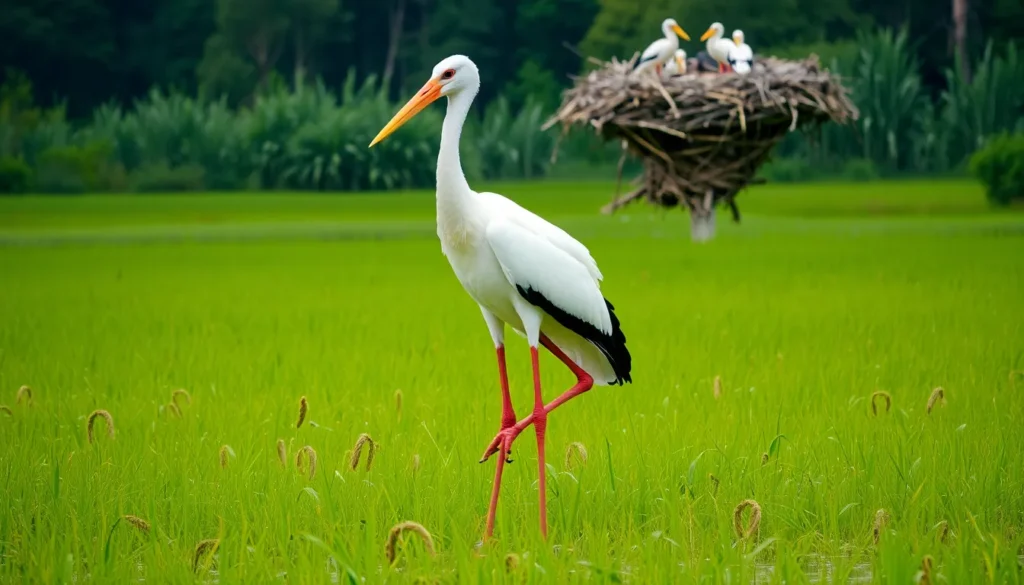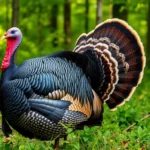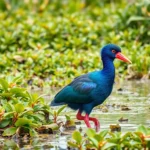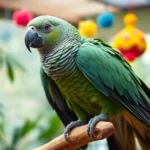When we think of iconic birds that capture our imagination, storks immediately come to mind with their impressive wingspan and legendary baby-delivering folklore. These magnificent creatures have graced our skies for millions of years, becoming symbols of new life and good fortune across countless cultures worldwide.
We’ve all heard the charming tales of storks bringing babies to families, but there’s so much more to discover about these remarkable birds. From their incredible migration journeys spanning thousands of miles to their unique nesting behaviors atop chimneys and towers, storks continue to fascinate wildlife enthusiasts and casual observers alike.
Whether you’re curious about the different stork species found across the globe or want to understand their vital role in maintaining ecological balance, we’re here to guide you through the captivating industry of these long-legged wonders. Let’s explore what makes storks truly extraordinary beyond the fairy tales we grew up believing.
Physical Characteristics of the Stork Bird
Stork birds possess remarkable physical features that make them instantly recognizable among waterfowl species. These magnificent creatures display distinctive anatomical traits that enable their remarkable lifestyle and migration patterns.
Size and Build
Storks rank among the largest wading birds in the industry, with impressive dimensions that vary significantly across species. The Marabou Stork stands as the tallest species, reaching heights of 60 inches (152 cm) and weighing up to 20 pounds (9 kg). White Storks measure between 39 to 45 inches (100-115 cm) in height with wingspans extending 61 to 85 inches (155-215 cm). Wood Storks typically reach 35 to 45 inches (89-114 cm) in height.
Most stork species exhibit sexual dimorphism, with males generally larger than females by 10-15% in both height and weight. Their robust build features powerful chest muscles that support extended flight periods during migration. Long, sturdy legs enable efficient wading through shallow waters and marshy terrain.
Distinctive Features
Long, pointed bills serve as the most recognizable stork characteristic, perfectly adapted for their feeding habits. Bill shapes vary by species: White Storks possess straight, orange bills measuring 6-8 inches (15-20 cm), while Wood Storks feature slightly curved, dark bills designed for tactile feeding. Adjutant Storks display massive bills that can exceed 12 inches (30 cm) in length.
Elongated necks stretch proportionally to body size, allowing storks to probe deep waters without submerging their bodies. Their necks contain 17-18 vertebrae, providing exceptional flexibility for precise movements during hunting. Bare facial skin appears prominently in many species, particularly around the throat and gular regions.
Plumage and Coloration
Stork plumage patterns create striking visual contrasts that distinguish species across different habitats. White Storks display predominantly white body feathers with black flight feathers creating dramatic wing patterns during flight. Their breeding season brings vibrant orange coloration to bills and legs.
Black Storks showcase glossy black plumage with metallic green and purple sheens across their backs and wings. Wood Storks present white bodies with dark gray to black heads and necks, earning them the nickname “flinthead.” Painted Storks exhibit the most colorful plumage, featuring pink tertial feathers, black bands, and bright yellow bills.
Juvenile storks typically display duller coloration than adults, with brown or gray tones replacing the stark contrasts found in mature birds. Molting occurs annually, with flight feathers replaced gradually to maintain flying capability throughout the year.
Different Species of Stork Birds
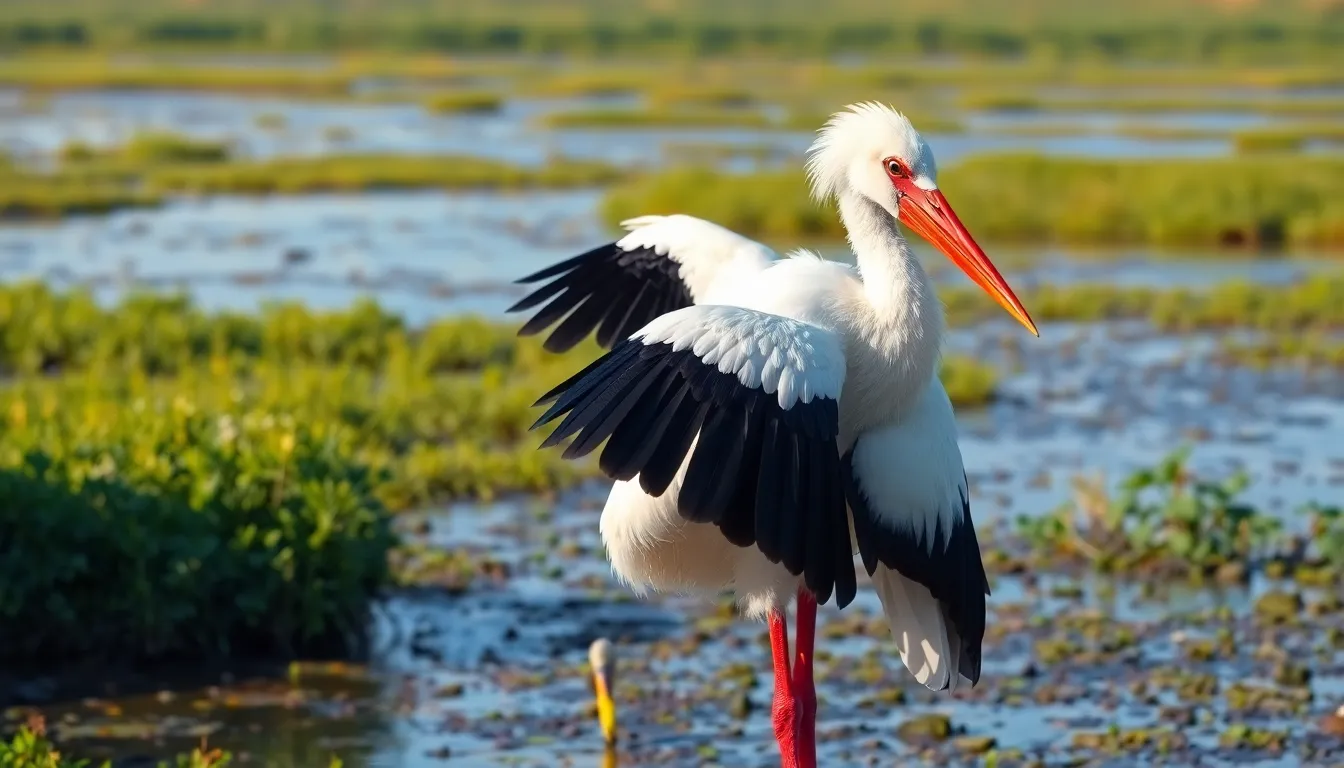
Storks cover 19 distinct species worldwide, each adapted to exact environments and habitats. These magnificent birds showcase remarkable diversity in size, coloration, and behavioral patterns across different continents.
White Stork
White Storks represent the most recognizable species in the stork family, standing 39 to 45 inches tall with wingspans reaching 91 inches. We observe their predominantly white plumage contrasted by striking black flight feathers and bright red bills that intensify during breeding season. These birds inhabit European wetlands, agricultural areas, and urban environments where they build massive platform nests on rooftops, church towers, and specially constructed poles.
European populations migrate approximately 6,000 miles annually to sub-Saharan Africa, following two primary routes through the Bosphorus and Gibraltar straits. White Storks consume frogs, fish, insects, small mammals, and reptiles, using their keen eyesight to hunt in shallow waters and grasslands. Their distinctive bill-clattering behavior serves as the primary form of communication since they lack functional vocal cords.
Black Stork
Black Storks display glossy black plumage with metallic green and purple sheens across their wings and back, while maintaining white underparts. These solitary birds measure 37 to 39 inches in height with wingspans extending 67 inches, making them slightly smaller than their white counterparts. We find Black Storks in forested regions near rivers, streams, and wetlands across Europe, Asia, and parts of Africa.
Unlike White Storks, these species prefer secluded woodland areas and build their nests in tall trees rather than human-made structures. Black Storks demonstrate more secretive behaviors, avoiding human contact and maintaining territories spanning 2 to 5 square miles. Their diet consists primarily of fish, amphibians, aquatic insects, and small crustaceans captured through patient stalking in shallow waters.
Marabou Stork
Marabou Storks claim the title of largest stork species, reaching heights of 60 inches and wingspans exceeding 138 inches. We recognize these African giants by their bare pink heads, distinctive throat pouches, and predominantly gray-black plumage with white underparts. Their massive bills measure up to 14 inches in length, perfectly adapted for their scavenging lifestyle.
These opportunistic feeders inhabit sub-Saharan Africa’s savannas, wetlands, and urban areas where they consume carrion, fish, insects, and small mammals. Marabou Storks often associate with vultures at carcass sites and demonstrate remarkable soaring abilities, utilizing thermal currents to cover vast distances with minimal energy expenditure. Their inflatable throat pouches serve as thermoregulatory organs during hot African days.
Wood Stork
Wood Storks represent North America’s only native stork species, measuring 33 to 40 inches tall with wingspans reaching 65 inches. We identify these wading birds by their distinctive featherless black heads, long curved bills, and white bodies accented by black flight feathers. Their specialized bills contain sensitive nerve endings that detect fish movement in murky waters through tactile feeding methods.
These birds inhabit freshwater and brackish wetlands throughout the southeastern United States, Central America, and northern South America. Wood Storks require exact water conditions with fish densities of 500 to 1,000 fish per acre to successfully breed and raise young. Colonial nesters, they construct stick platforms in cypress trees and mangroves, often forming rookeries containing 25 to 30 breeding pairs.
Natural Habitat and Distribution
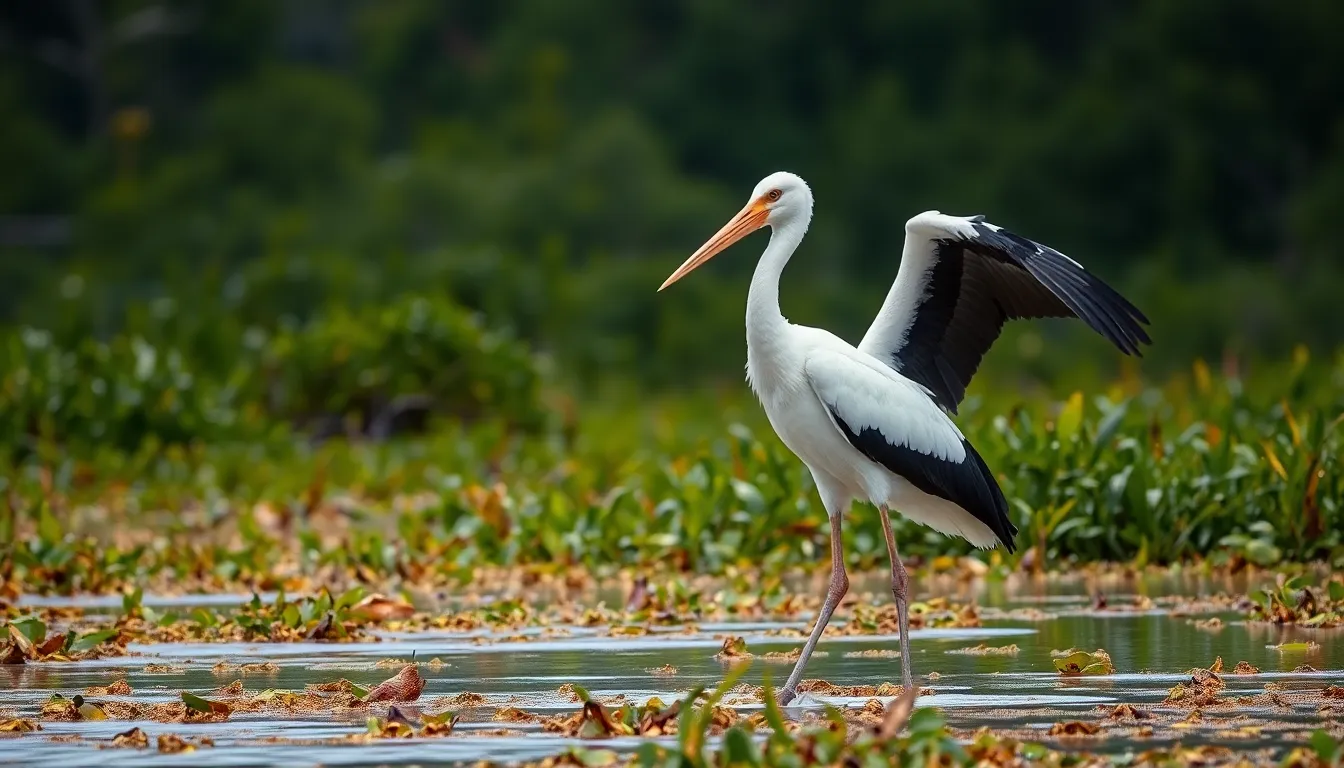
Stork birds inhabit diverse environments across six continents, with Antarctica being the sole exception. These remarkable waders demonstrate exceptional adaptability to various climatic conditions and geographic regions.
Geographic Range
Europe hosts the largest populations of White Storks, with Germany maintaining over 4,500 breeding pairs and Poland supporting approximately 52,000 pairs. Africa serves as both a permanent home for 8 species and a crucial wintering destination for European migrants. Asia accommodates 9 distinct stork species, including the endangered Oriental Stork found primarily in China, Japan, and eastern Russia.
North America contains only the Wood Stork as its native species, concentrated in Florida, Georgia, and South Carolina. South America supports 3 species: the Maguari Stork, Jabiru, and Wood Stork populations extending from Central America. Australia houses the Black-necked Stork across northern regions and eastern coastal areas.
| Region | Native Species Count | Notable Species |
|---|---|---|
| Europe | 2 | White Stork, Black Stork |
| Africa | 8 | Marabou Stork, Saddle-billed Stork |
| Asia | 9 | Oriental Stork, Asian Openbill |
| North America | 1 | Wood Stork |
| South America | 3 | Jabiru, Maguari Stork |
| Australia | 1 | Black-necked Stork |
Preferred Environments
Wetlands represent the primary habitat choice for most stork species, providing essential feeding grounds rich in fish, amphibians, and aquatic invertebrates. Shallow marshes with water depths between 6-24 inches create optimal foraging conditions for tactile feeding behaviors. Agricultural landscapes attract White Storks, which hunt insects, small mammals, and reptiles in plowed fields and grasslands.
Forest edges and wooded areas appeal to Black Storks, offering secluded nesting sites away from human disturbance. Open savannas and grasslands support species like the Marabou Stork, enabling efficient scavenging of carrion across vast territories. Coastal regions provide important stopover points during migration, with estuaries and tidal flats offering abundant prey resources.
Urban environments increasingly accommodate stork populations, particularly in Europe where White Storks nest on rooftops, church towers, and specially constructed platforms. Riverine systems create migration corridors connecting breeding and wintering grounds across continents.
Diet and Feeding Behavior
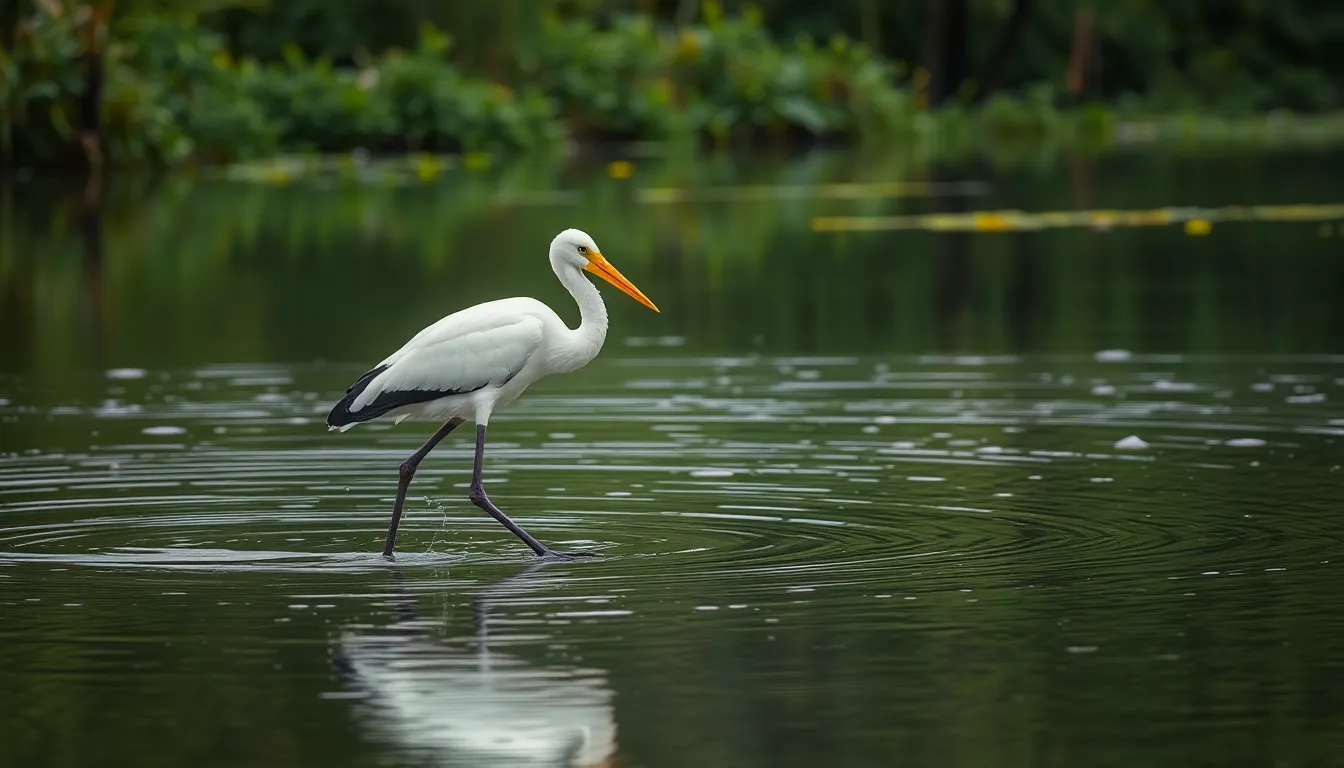
Storks employ diverse feeding strategies that showcase their adaptability across different ecosystems. These opportunistic feeders demonstrate remarkable hunting prowess while maintaining their ecological roles as both predators and scavengers.
Hunting Techniques
Stork species use distinct hunting methods based on their habitat preferences and prey availability. White Storks employ a methodical walking pattern through shallow waters, using their sensitive bills to detect prey through tactile feeding. This technique allows them to locate frogs, fish, and aquatic invertebrates in murky water conditions.
Wood Storks demonstrate specialized grope feeding behavior by opening their bills underwater and snapping them shut when prey touches the sensitive interior surfaces. The reaction time measures just 25 milliseconds, making it one of the fastest feeding reflexes in the avian industry. Marabou Storks combine scavenging with active hunting, often following vultures to carcass sites while also catching live prey such as flamingo chicks and fish.
Black Storks prefer solitary hunting in forest streams and secluded wetlands, using patient stalking techniques to capture fish, amphibians, and small mammals. Their dark plumage provides excellent camouflage against shadowy water environments. Oriental Storks wade through rice paddies and marshlands, employing both visual and tactile hunting methods to secure aquatic prey.
Primary Food Sources
Fish constitute the primary dietary component for most stork species, comprising 60-80% of their total food intake during breeding seasons. Common targets include carp, pike, eels, and various minnow species found in shallow freshwater environments. Wood Storks specifically target fish populations measuring 2-6 inches in length, concentrating their feeding efforts when water levels recede and concentrate prey.
Amphibians represent the second most important food category, particularly frogs and salamanders that storks capture during breeding migrations. White Storks consume an estimated 400-500 frogs annually per individual, with peak consumption occurring during spring months when amphibian populations emerge from hibernation.
Crustaceans and aquatic invertebrates provide essential protein sources, including crayfish, water beetles, dragonfly larvae, and various worm species. Painted Storks demonstrate particular expertise in capturing freshwater crabs and large insects in Asian wetlands. Small mammals such as rodents, young rabbits, and occasionally bird nestlings supplement their diets when aquatic prey becomes scarce.
Reptiles including snakes, lizards, and small turtles contribute to stork nutrition, especially for species inhabiting warmer climates. Marabou Storks exhibit the most diverse diet range, consuming everything from termite swarms to large fish weighing up to 2 pounds, demonstrating their remarkable feeding flexibility across African savannas and wetlands.
Breeding and Nesting Patterns
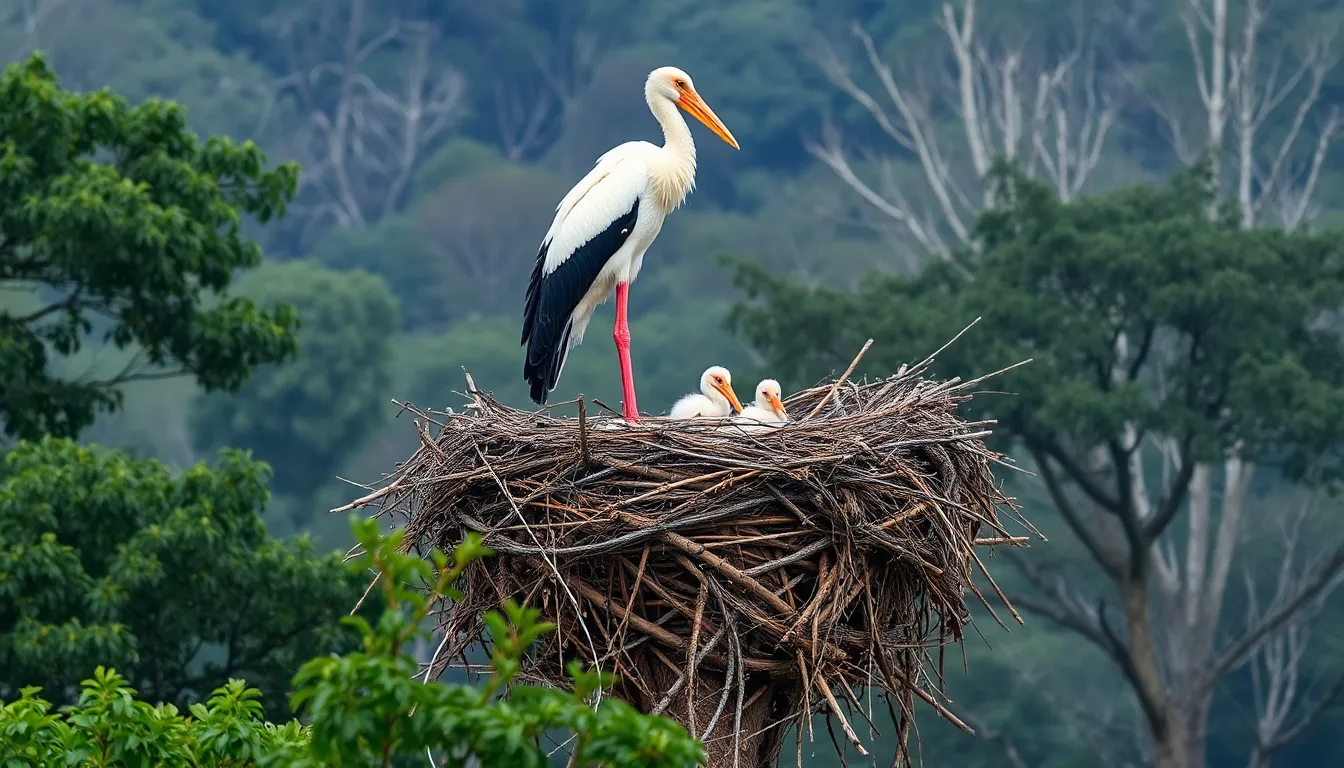
Stork breeding patterns showcase remarkable complexity in their reproductive strategies. These magnificent birds establish intricate social bonds and demonstrate exceptional dedication to their offspring throughout extended breeding cycles.
Mating Rituals
Stork courtship displays begin with elaborate ceremonies that strengthen pair bonds between potential mates. Males initiate these rituals by performing distinctive head movements called “up-down” displays while clattering their bills rhythmically at frequencies reaching 8-10 beats per second. White Storks engage in synchronized bill clattering duets that can last up to 45 minutes during peak courtship periods.
Territorial behaviors intensify as males defend nesting sites through aggressive posturing and wing spreading displays. Females assess male fitness by observing nest construction quality and territorial defense capabilities before selecting their mates. Copulation occurs multiple times daily during the fertile period, with pairs reinforcing their bonds through mutual preening sessions.
Gift presentation rituals involve males bringing nesting materials and food items to demonstrate their provisioning abilities. Black Storks perform unique “balancing acts” where males stand on one leg while extending their wings to showcase their physical prowess to potential mates.
Nest Construction
Stork nests represent engineering marvels constructed from interwoven branches, twigs, and various organic materials. These structures typically measure 3-6 feet in diameter and can reach heights of 8 feet after multiple breeding seasons of additions. White Stork pairs return to the same nest sites annually, adding 20-30 pounds of new materials each season.
Construction begins with the establishment of a solid foundation using sturdy branches measuring 1-2 inches in diameter. Males gather primary structural materials while females arrange and weave them into the nest framework. Marabou Storks incorporate unusual materials including bones, plastic debris, and metal fragments into their nest construction.
Nest placement varies significantly among species, with Wood Storks preferring tree heights of 40-60 feet in cypress swamps and mangrove systems. Black Storks select cliff ledges and remote forest locations, constructing their nests 30-100 feet above ground level. Urban stork populations increasingly use man made structures including church spires, communication towers, and building rooftops for nesting sites.
Interior nest chambers feature soft lining materials such as grasses, feathers, and moss to cushion eggs during incubation. Nest maintenance continues throughout the breeding season as pairs replace deteriorated materials and reinforce structural integrity against weather damage.
Parental Care
Stork parental investment extends over periods ranging from 14-16 weeks from egg laying through fledgling independence. Incubation duties alternate between both parents in shifts lasting 3-4 hours, maintaining egg temperatures at optimal 99-100°F throughout the 28-35 day incubation period. White Storks typically lay 2-5 eggs with incubation success rates averaging 85% under favorable conditions.
Feeding responsibilities intensify dramatically once chicks hatch, with parent pairs making 60-80 feeding trips daily during peak growth periods. Adults regurgitate partially digested food directly into chick mouths during the first 3 weeks before transitioning to whole prey items. Wood Stork parents demonstrate remarkable efficiency, delivering 400-500 grams of fish daily to support rapidly growing offspring.
Brooding behaviors provide essential thermoregulation for nestlings unable to maintain body temperature independently. One parent remains at the nest continuously during the first 10-14 days while the other forages for food resources. Temperature regulation becomes critical as chicks lack adequate feather insulation until reaching 4-5 weeks of age.
Fledgling development progresses through distinct stages, with young storks developing flight capabilities at 8-10 weeks but remaining dependent on parental feeding for an additional 4-6 weeks. Parents guide fledglings to productive foraging areas and demonstrate hunting techniques through behavioral modeling. Family groups often remain together during initial migration journeys, with juveniles learning essential navigation skills from experienced adults.
Migration Patterns of Stork Birds
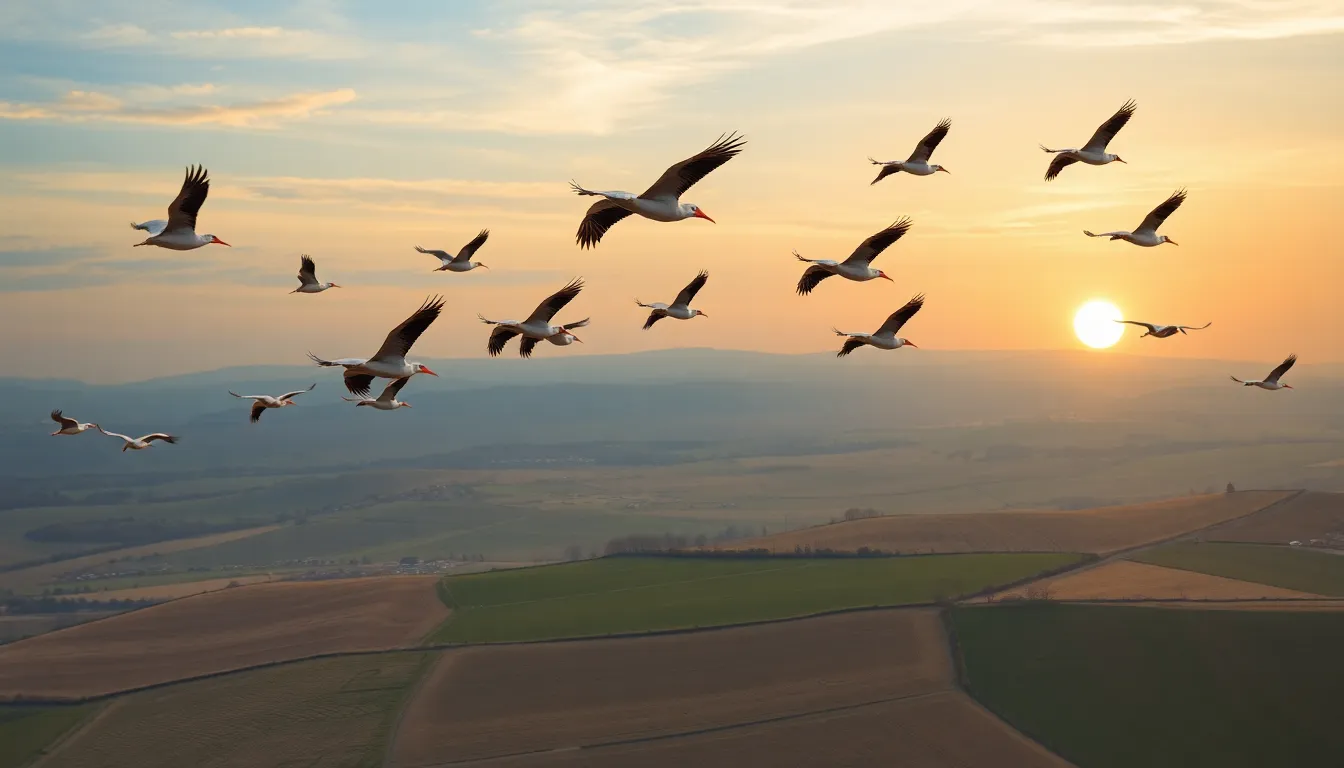
Stork bird migration represents one of nature’s most remarkable long-distance journeys. These magnificent birds demonstrate exceptional navigational abilities during their seasonal movements across continents.
Seasonal Movement
Migration timing varies significantly among stork species based on their geographic locations and breeding cycles. White Storks initiate their southward journey between August and September when European temperatures begin declining.
Peak migration activity occurs during exact thermal conditions that provide optimal lift for soaring flight. European populations concentrate their movements within a 6-8 week window to maximize energy efficiency.
Black Storks begin migration approximately 2-3 weeks earlier than White Storks due to their preference for warmer climates during winter months. Oriental Storks in Asia follow similar patterns with departure times coinciding with monsoon season changes.
Temperature triggers play crucial roles in determining exact departure dates. Stork populations monitor environmental cues such as daylight duration and food availability to synchronize their movements.
Return migration begins in February for most African wintering populations. Spring arrivals at European breeding grounds occur between March and April when weather conditions stabilize.
Migration Routes
European White Storks follow two primary migration corridors to reach their African wintering grounds. Western populations traverse the Iberian Peninsula and cross the Strait of Gibraltar into Morocco.
Eastern route migrants concentrate along the Bosphorus in Turkey before continuing through the Middle East toward the Rift Valley. This eastern pathway accommodates approximately 500,000 White Storks annually.
Geographic barriers force storks to use exact crossing points where land masses narrow. The Strait of Gibraltar processes 250,000 storks during peak migration periods in September.
African migration routes extend along the Nile Valley and Great Rift Valley systems. These corridors provide consistent thermal updrafts and abundant food resources during the journey.
Asian stork species use different pathways connecting breeding grounds in Siberia and China to wintering areas in Southeast Asia. Oriental Storks follow coastal routes along the Yellow Sea before reaching their destinations.
Distance measurements reveal extraordinary migration capabilities among stork populations. Some White Storks cover 10,000 kilometers during their annual round trip between Europe and sub-Saharan Africa.
Navigation accuracy remains consistent across generations with juvenile storks learning routes from experienced adults during their first migration. Magnetic compass orientation and celestial navigation combine to ensure successful long-distance travel.
Cultural Significance and Symbolism
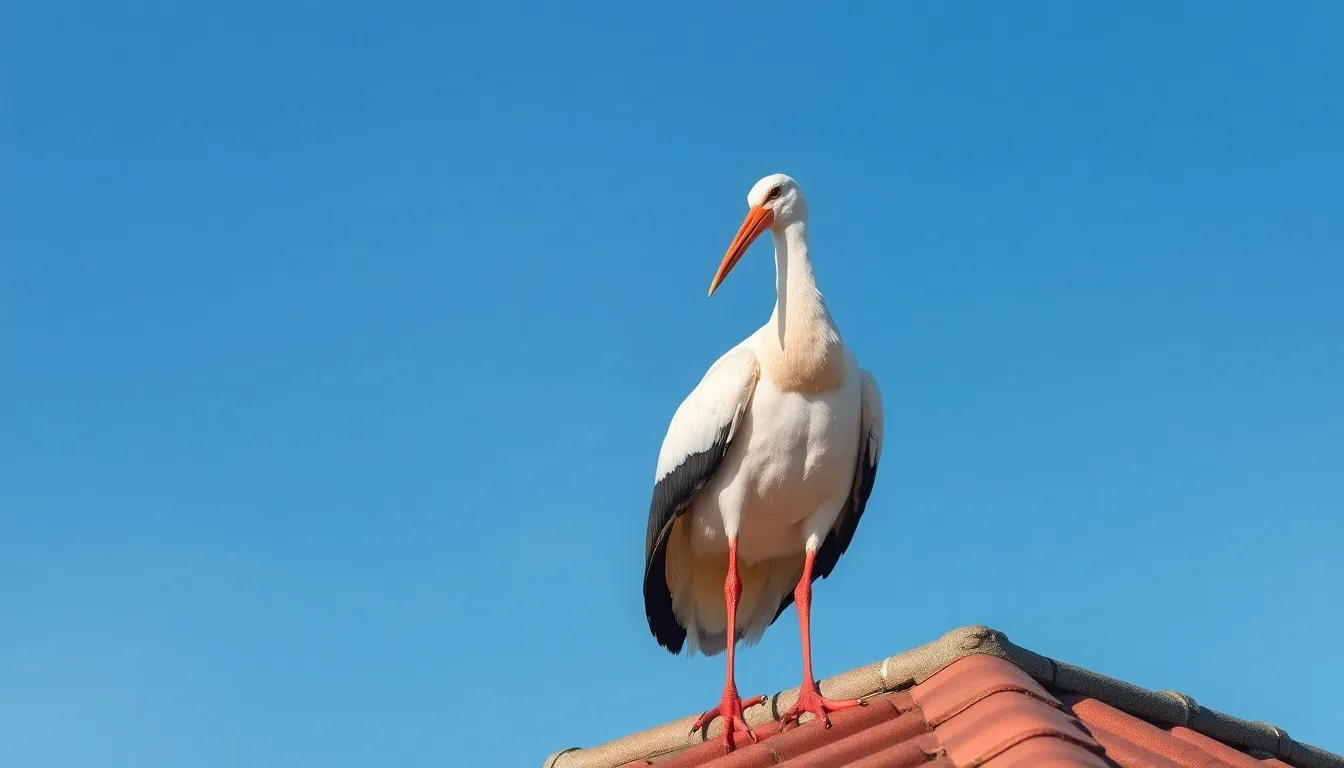
Stork birds have woven themselves deeply into human culture across millennia, becoming powerful symbols that transcend geographic boundaries. These magnificent creatures carry profound meaning in folklore, religious traditions, and modern society.
Folklore and Mythology
Ancient civilizations revered storks as sacred messengers between earthly and divine realms. Greek mythology portrayed storks as symbols of filial piety, inspired by their observed care for aging parents and dedication to family units. Roman culture embraced storks as harbingers of spring and renewal, celebrating their punctual return from African wintering grounds.
European folklore established the enduring baby delivery legend during medieval times, particularly in Germanic and Dutch traditions. Parents told children that storks brought newborns in bundles, explaining mysterious arrivals while avoiding difficult conversations. This tale gained popularity because White Storks often nested on rooftops and chimneys, creating visible connections between homes and new family members.
Egyptian mythology connected storks to the soul’s journey in the afterlife, depicting these birds in tomb paintings and religious ceremonies. Asian cultures, particularly in China and Japan, viewed storks as symbols of longevity and wisdom, incorporating their imagery into art and literature spanning centuries. Aboriginal Australian dreamtime stories feature storks as creators of wetlands and protectors of water sources.
Nordic folklore described storks as weather predictors, with their migration timing indicating harsh winters or early springs. Slavic traditions considered stork nests on homes as blessings that brought prosperity and protection from evil spirits.
Modern Cultural References
Contemporary media continues celebrating stork symbolism through animated films, children’s books, and advertising campaigns. Disney’s animated productions feature storks as central characters, reinforcing traditional associations with birth and family formation. Companies specializing in baby products frequently incorporate stork imagery in logos and marketing materials.
Modern conservation movements have adopted storks as flagship species representing wetland preservation efforts. Wildlife organizations use White Stork populations as indicators of environmental health, making these birds symbols of ecological awareness. Urban planning initiatives in European cities now accommodate stork nesting platforms, demonstrating cultural respect for traditional beliefs.
Social media platforms showcase stork migration patterns through live cameras and tracking technology, creating new forms of cultural engagement. Educational programs in schools use stork life cycles to teach children about nature conservation and animal behavior. Corporate mascots featuring storks appear in industries ranging from healthcare to telecommunications, leveraging their positive cultural associations.
National symbols include storks on currency and postal stamps in countries like Belarus and Lithuania, where these birds represent national identity and natural heritage.
Conservation Status and Threats
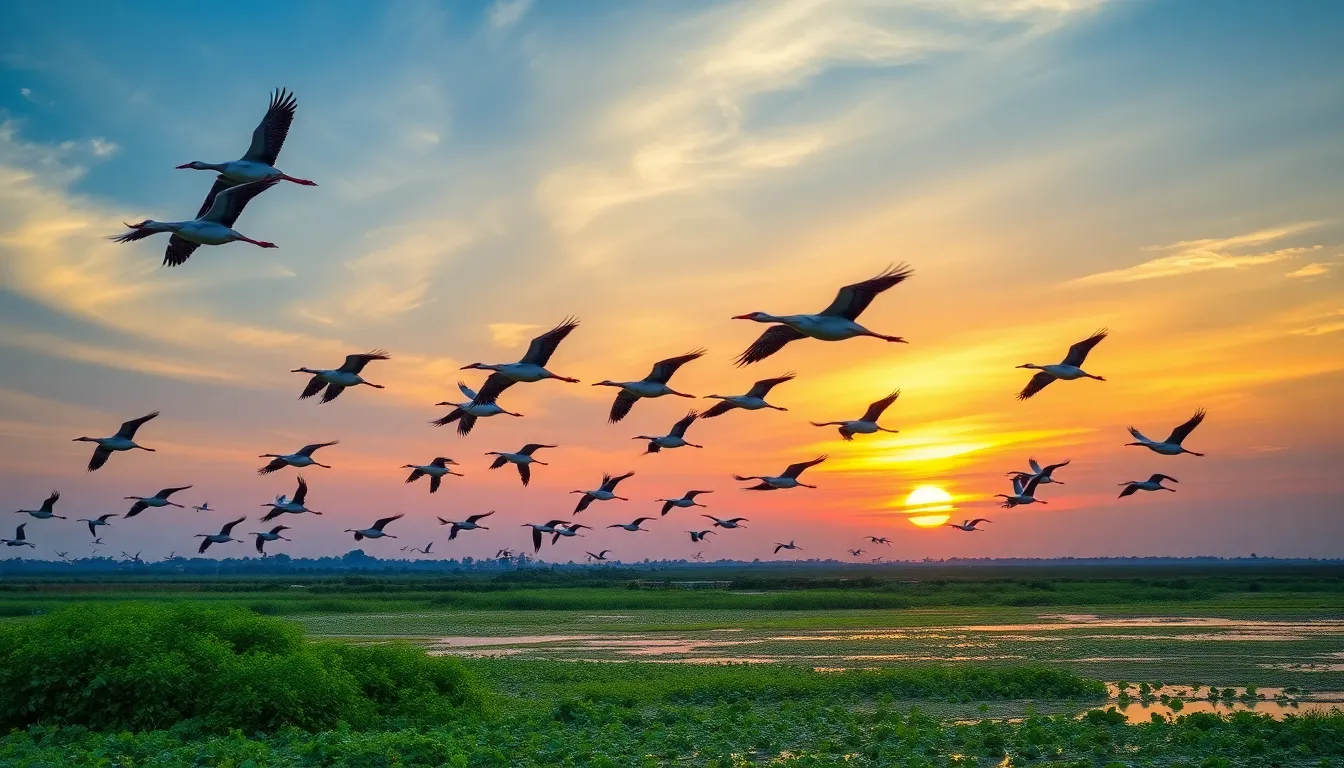
Stork bird populations face mounting pressures across their global range, with several species experiencing important declines that threaten their long-term survival. These magnificent birds, once thriving across diverse ecosystems, now confront an array of environmental challenges that impact their breeding success and migration patterns.
Population Trends
White Stork populations demonstrate contrasting trends across different regions, with Western European numbers recovering from historical lows while Eastern populations continue declining. Germany hosts approximately 4,500 breeding pairs as of 2023, representing a substantial recovery from fewer than 3,000 pairs in the 1980s. Poland supports the largest European population with over 52,000 breeding pairs, though this figure represents a 15% decline from peak numbers recorded in the early 2000s.
Black Stork populations remain more stable but significantly smaller, with European breeding pairs totaling roughly 19,000 individuals. Russia contains the largest Black Stork population with an estimated 8,000-12,000 breeding pairs distributed across vast forested regions. Spain and France each support between 1,500-2,000 pairs, marking gradual increases over the past two decades.
Oriental Storks face the most critical population status among all stork species, with fewer than 3,000 individuals remaining in the wild. China contains approximately 1,000 breeding pairs, while Russia supports 800-1,200 pairs in the Amur River basin. Japan’s reintroduction programs have successfully established 150 breeding pairs since 2005.
Wood Stork populations in North America have shown remarkable recovery following Endangered Species Act protection, increasing from 5,000 breeding pairs in the 1970s to over 10,000 pairs currently. Florida hosts the largest concentration with 7,500 breeding pairs distributed across the Everglades and coastal regions. Georgia maintains stable populations of 1,800 pairs, while South Carolina supports approximately 800 breeding pairs.
Marabou Stork populations remain relatively stable across sub-Saharan Africa, with an estimated 500,000 individuals continent-wide. Kenya and Tanzania each support populations exceeding 100,000 birds, while Ethiopia maintains approximately 75,000 individuals in highland and lowland regions.
Environmental Challenges
Habitat loss represents the primary threat facing stork bird populations worldwide, with wetland destruction eliminating 87% of global freshwater marshes since 1700. Agricultural expansion accounts for 60% of wetland conversion in Europe, directly impacting breeding grounds for White Storks and Black Storks. Urban development eliminates 15,000 hectares of stork habitat annually across major European river systems.
Water management practices disrupt feeding opportunities for stork species dependent on seasonal flooding cycles. Dam construction along migration corridors blocks 40% of major rivers used by storks, reducing fish availability during critical breeding periods. Irrigation projects divert water from natural wetlands, creating food scarcity for 75% of stork populations in Mediterranean regions.
Climate change alters precipitation patterns across stork ranges, with drought conditions extending breeding seasons and reducing reproductive success. Temperature increases of 2.3°C in sub-Saharan Africa since 1980 have shifted insect emergence timing, creating mismatches between stork arrival and peak food availability. Extreme weather events during migration cause 25% higher mortality rates among juvenile storks compared to historical averages.
Collision mortality with power infrastructure kills an estimated 12,000 storks annually across Europe, with transmission lines causing 80% of documented fatalities. Wind turbine installations along migration routes contribute to 2,500 additional deaths per year, particularly affecting large soaring species. Communication towers and guy-wires account for another 3,000 stork mortalities during nocturnal migration segments.
Pesticide contamination reduces prey availability and causes direct poisoning in stork populations. Organochlorine residues detected in 45% of stork eggs tested across Europe exceed safe thresholds for successful reproduction. Agricultural chemicals eliminate aquatic invertebrates essential for chick development, reducing fledging success by 30% in affected areas.
Illegal hunting continues impacting stork populations even though protective legislation, with 8,000 individuals killed annually across the Mediterranean region. Lebanon and Syria account for 40% of documented hunting incidents during spring migration periods. Traditional hunting practices in parts of Africa remove 15,000 storks yearly from local populations, particularly targeting large species like Marabou Storks.
Human disturbance at nesting sites causes abandonment rates of 20% among urban-nesting stork colonies. Construction activities during breeding seasons force relocation of established pairs, reducing reproductive output by 35% compared to undisturbed sites. Tourism pressure at traditional nesting locations creates stress responses that impact feeding efficiency and chick survival rates.
Conclusion
Storks continue to captivate us with their remarkable adaptability and enduring presence across cultures worldwide. These magnificent birds demonstrate nature’s incredible diversity through their varied species unique feeding strategies and impressive migratory journeys that span thousands of miles.
While some populations face important conservation challenges others show promising recovery through dedicated protection efforts. We’ve witnessed how habitat preservation and human awareness can make a real difference in securing their future.
As we move forward it’s clear that storks will remain important indicators of environmental health and symbols of hope. Their survival depends on our continued commitment to protecting the wetlands agricultural landscapes and migration corridors they need to thrive for generations to come.
Frequently Asked Questions
How many species of storks exist worldwide?
There are 19 distinct species of storks found across the globe, each adapted to specific environments and habitats. These species are distributed across six continents, with the exception of Antarctica, showcasing remarkable diversity in size, behavior, and ecological roles.
What do storks primarily eat?
Storks are opportunistic feeders with fish comprising 60-80% of their diet during breeding seasons. They also consume amphibians, crustaceans, small mammals, and insects. Different species employ various hunting techniques, from methodical wading in shallow waters to rapid feeding reflexes.
Where do storks typically build their nests?
Storks build nests in various locations including tall trees, rooftops, chimneys, and man-made structures like cell towers. Their nests can grow impressively large over time as pairs return annually to the same location, adding new materials each breeding season.
How far do storks migrate?
Storks undertake remarkable migration journeys, with some species like White Storks traveling up to 10,000 kilometers between breeding and wintering grounds. They use two primary migration corridors in Europe and rely on magnetic compass orientation and celestial navigation for successful long-distance travel.
What cultural significance do storks hold?
Storks have deep cultural significance across civilizations, symbolizing family devotion, renewal, and good fortune. The famous folklore of storks delivering babies originates from European traditions, while various cultures have revered them as sacred messengers and symbols of new life.
Are stork populations endangered?
Several stork species face conservation challenges, with the Oriental Stork being critically endangered. While White Stork populations have recovered in Western Europe, Eastern populations continue to decline. Habitat loss, climate change, and human disturbances are primary threats to stork populations globally.
How big can storks get?
Storks vary significantly in size among species. The Marabou Stork is the largest, reaching heights of up to 60 inches with impressive wingspans. Males are generally larger than females due to sexual dimorphism, and all species possess powerful chest muscles and long legs adapted for migration and wading.
Do storks mate for life?
Storks typically exhibit strong pair bonds and often return to the same nesting sites with the same partners annually. However, they don’t necessarily mate for life, as partnerships can change if one partner fails to return to the breeding grounds or if breeding attempts are unsuccessful.

